

NEBRASKA MUNICIPAL REVIEW
Issue No. 1,207
The NEBRASKA MUNICIPAL REVIEW (ISSN 0028–1906) is published monthly and the official publication of the League of Nebraska Municipalities, an association of the cities and villages of Nebraska, published at 1335 L St., Lincoln, Nebraska 68508. Subscription rates are $5 per single copy — $50 plus tax for 12 issues. Periodicals postage paid at Lincoln, Nebraska. Views of contributors, solicited or unsolicited, are their own and not to be construed as having the endorsement of the League unless specifically and explicitly stated by the publisher
The NEBRASKA MUNICIPAL REVIEW is a nonprofit publication administered and supervised by the League of Nebraska Municipalities. All revenue derived from the publication is used by the association to defray publication costs.
League of NE Municipalities staff 402-476-2829 • www.lonm.org
L. Lynn Rex, Executive Director
Christy Abraham, Legal Counsel
Lash Chaffin, Utilities Section Director
Cherie DeFreece, Admin Assistant/ Membership Services Assistant
Brenda Henning, Membership Services Assistant/ LIGHT Admin Assistant
Ethan Nguyen, LNM/LARM Information Technology Manager
Shirley Riley, Membership Services Director
Jackson Sash, Utilities Field Representative/Training Coordinator
Ashley Wolfe, Marketing/Communications Director
LARM staff
Dave Bos, Executive Director
Tracy Juranek, Asst. Executive Director, Customer Service Specialist
Diane Becker, Communications/Marketing Director
Kyla Brockevelt, Executive Administrative Assistant
Drew Cook, Customer Service Specialist
John Hobbs, Loss Control Specialist
James Kelley, Loss Control Specialist
Fred Wiebelhaus, Loss Control/Claims Manager
POSTMASTER: SEND ADDRESS CHANGES TO NEBRASKA MUNICIPAL REVIEW, 1335 L STREET, LINCOLN, NEBRASKA 68508.
Have an idea, project or opinion to share? The League welcomes member articles, information, and op-eds.
Want to reach local decision makers? The League can help you get your message out to Nebraska’s 3,500+ municipal officials.To learn more, contact Ashley Wolfe at 402-476-2829 or ashleyw@lonm.org
President Marlin Seeman, Mayor, Aurora
President-Elect

What's inside?
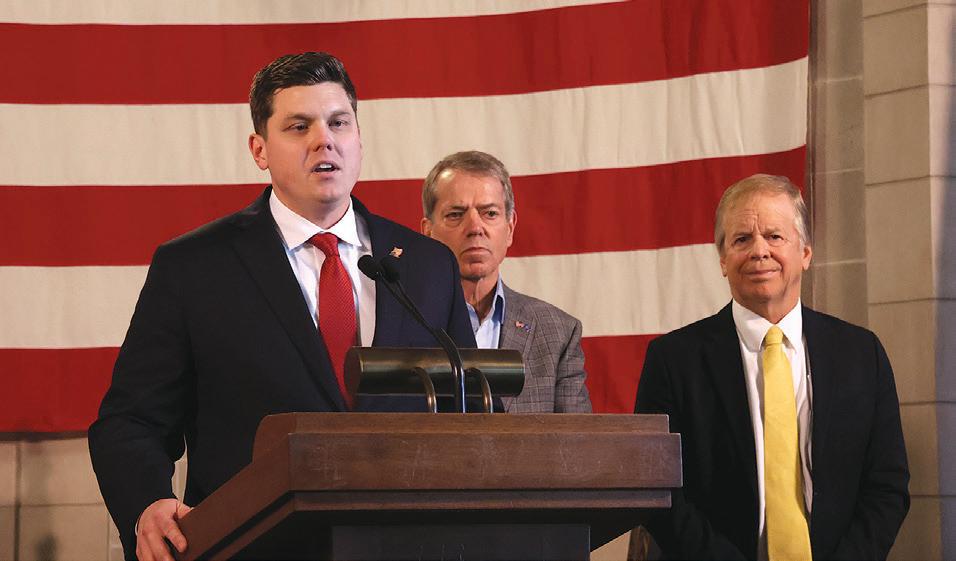
New State Treasurer
League hosts lunch and EMS briefing
Legislative Committees meet to highlight focus for upcoming legislative session
Center for Rural Affairs: Top 5 grant writing tips for rural leaders
AI in state and local government: Section 4 - Three key phases of AI adoption
Hope beyond borders: Columbus Fire Department helps Zacapu firefighters
Ralston: Significant donation jumpstarts community project
Nebraska Game & Parks: What will be new in 2026?
Municipal clerks and treasurers attend statewide training in Wakefield
Bryan Bequette, Mayor, Nebraska City
Vice President David Black, Mayor, Papillion Past President Deb VanMatre, Former Mayor, Gibbon
Directors
Leirion Gaylor Baird
John W. Ewing, Jr.
Mayor, Lincoln
Mayor, Omaha
Sharon Powell Village Board President, Utica
Larry Evans Mayor, Minden
Rod Petersen Mayor, Louisville
Jim Bulkley Mayor, Columbus
Betsy Vidlak Mayor, Scottsbluff
Pat Heath City Administrator, Gering
Janine K. Schmidt
CMC/Treasurer, Morrill
Kyle Svec City Admin./Utilities Supervisor, Geneva
Affiliated Sections
City Managers
Wes Blecke, Wayne Clerks
Munic. Accounting & Finance
Tami L. Comte, David City
Becky Erdkamp, Exeter Fire Chiefs Dennis Thompson, North Platte
Utilities Pat Heath, Gering 28
South Sioux City: Local and state collaboration creates hundreds of jobs, generates more than $300M in economic investments
The Director's Message - L. Lynn Rex, LNM Executive Director - Significant economic impact of “Creative Districts” is well documented across Nebraska!
LARM – From accident to improvement: A supervisor’s role
The Legal Corner by Tara Stingley, Cline Williams Wright Johnson & Oldfather, L.L.P. - Preventing and addressing sexual harassment in the workplace
A photo of a mural finished in 2021 celebrating the 150th anniversary of the City of Sutton. Photo by Josh Wolfe.
Larger Cities Legislative Committee
John McGhehey, Mayor, Alliance
Seth Sorensen, City Manager, Alliance
Tobias Tempelmeyer, City Administrator, Beatrice
Rusty Hike, Mayor, Bellevue
Jim Ristow, City Administrator, Bellevue
Mindy Rump, Mayor, Blair
Phil Green, City Administrator, Blair
Tom Menke, City Manager, Chadron
Jim Bulkley, Mayor, Columbus
Tara Vasicek, City Administrator, Columbus
Dave Bauer, Mayor Crete
Tom Ourada, City Administrator, Crete
Jody Sanders, City Administrator, Fremont
Kent Ewing, Mayor, Gering
Pat Heath, City Administrator, Gering
Roger Steel, Mayor, Grand Island
Mike Evans, Mayor, Gretna
Paula Dennison, City Administrator, Gretna
Mark Funkey, City Administrator, Hastings
James Liffrig, Mayor, Holdrege
Chris Rector, City Administrator, Holdrege
Brenda Jensen, City Manager, Kearney
Brad DeMers, Asst. City Manager, Kearney
Doug Kindig, Mayor, La Vista
Kevin Pokorny, Director of Administrative Services, La Vista
John Fagot, Mayor, Lexington
Joe Pepplitsch, City Manager, Lexington
Margaret Blatchford, Assistant City Attorney, Lincoln
Riley Slezak, Senior Advisor to the Mayor, Lincoln
Linda Taylor, Mayor, McCook
Nate Schneider, City Manager, McCook
Bryan Bequette Mayor, Nebraska City
Perry Mader, City Administrator, Nebraska City
Justin Webb, Council Member, Norfolk
Scott Cordes, City Administrator, Norfolk
Brandon Kelliher, Mayor, North Platte
Layne Groseth, City Administrator, North Platte
Steve Krajewski, Mayor, Ogallala
Kevin Wilkins, City Manager, Ogallala
Thomas Warren, Chief of Staff, Omaha
David Black, Mayor, Papillion
Amber Powers, City Administrator, Papillion
R. Paul Lambert, Mayor, Plattsmouth
Emily Bausch, City Administrator, Plattsmouth
Don Groesser, Mayor, Ralston
Brian Kavanaugh, Council Member, Ralston
Jack Cheloha, City Administrator, Ralston
Art Lindberg, Mayor, Schuyler
Lora Johnson, City Administrator, Schuyler
Betsy Vidlak, Mayor, Scottsbluff
Kevin Spencer, City Manager, Scottsbluff
Joshua Eickmeier, Mayor, Seward
Greg Butcher, City Administrator, Seward
Brandon Bonregard, Mayor, Sidney
Brett Kerkman, Vice-Mayor, Sidney
Lance Hedquist, City Administrator, South Sioux City
Jill Brodersen, Mayor, Wayne
Wes Blecke, City Administrator, Wayne
Barry Redfern, Mayor, York
Dr. Sue Crawford, City Administrator, York
Smaller Cities Legislative Committee
Chaired by Tom Goulette, City Administrator of West Point
Lisa Schroedl, City Administrator/Clerk/Treasurer, Ainsworth
Jessica Quady, City Administrator, Ashland
Crystal Dunekacke, City Administrator/Economic Developer, Auburn
Marlin Seeman, Mayor, Aurora
Adam Darbo, City Administrator, Aurora
Chris Anderson, City Administrator, Central City
Andrew Lee, Admin/Clerk/Treasurer, Curtis
Tami Comte, Clerk/Treasurer, David City
Alan Michl, Chairperson, Exeter
Becky Erdkamp, Clerk/Treasurer, Exeter
Kyle Svec, City Administrator, Geneva
Matt Smallcomb, City Administrator, Gibbon
Gary Greer, City Administrator, Gothenburg
Jana Tietjen, Clerk, Hebron
Barb Straub, Admin/Clerk/Treasurer, Hemingford
Kelly Oelke, City Administrator, Hickman
Janine K. Schmidt, CMC/Treasurer, Morrill
Sandra Schendt, Clerk/Treasurer, Nelson
David Russell, Director of Gov. Affairs, NMPP Energy
Sandy Kruml, Clerk/Treasurer, Ord
Mike Feeken, Mayor, St. Paul
Sandra Foote, Council Member, Superior
Warren Myers, City Administrator, Sutton
Jessica Meyer, City Administrator, Syracuse
Kelly Adamson, City Council Member, Tekamah
Sharon Powell, Village Board President, Utica
Kyle Arganbright, Mayor, Valentine
Melissa Harrell, City Administrator, Wahoo
Desiree Soloman, City Attorney, Waterloo
Stephanie Fisher, City Administrator, Waverly
Tom Goulette, City Admin./Utility Superintendent, West Point
Randy Woldt, Utilities Superintendent, Wisner
Robert Costa, Community Planner, Yutan

Municipal Legal Calendar
(All statute citations to Revised Statutes of Nebraska)
JANUARY 2026
CITIES OF THE FIRST CLASS
• Each month - Clerk publishes ordinances passed within 15 days after passage. (16-405)
• Within 10 working days from meeting or before next meeting (whichever is sooner) Clerk to have minutes available for public inspection. (84-1413)
• First Regular Meeting - Mayor and Council appoint member of Park Board. (16-696)
• Within 30 days from Council meeting Clerk publishes official proceedings of meeting. (19-1102)
• Within 20 days after end of month Treasurer files monthly financial report. (16-318)
• On or before January 31- Provide county assessor each new lease or changed preexisting lease which went into effect during the previous year and a listing of previously reported leases that are still in effect. (77-202.11)
• Each Quarter - Report from depository banks due. (16-714)
• Reminder - Notice of automatic renewal of liquor and beer other than Class C licenses must be published between January 10 and January 30 of each year. (53-135.01)
• By January 31 - Clerk submits list of authorized tobacco licenses to the Department of Revenue.
CITIES OF THE SECOND CLASS
• Each month - Clerk publishes ordinances passed within 15 days after passage (17-613)
• Within 10 working days from meeting or before next meeting (whichever is sooner) Clerk to have minutes available for public inspection. (84-1413)
• Within 30 days from Council meeting Clerk publishes official proceedings of meeting. (19-1102)
• Within 20 days after end of month Treasurer files monthly financial report. (17-606)
• On or before January 31- Provide county assessor each new lease or changed preexisting lease which went into effect during the previous year and a listing of previously reported leases that are still in effect. (77-202.11)
• Reminder - Notice of automatic renewal of liquor and beer other than Class C licenses must be published between January 10 and January 30 of each year. (53-135.01)
• By January 31 - Clerk submits list of authorized tobacco licenses to the Department of Revenue.
VILLAGES
• Each month - Clerk publishes ordinances passed within 15 days after passage (17-613)
• Within 10 working days from meeting or before next meeting (whichever is sooner) Clerk to have minutes available for public inspection. (84-1413)
• Within 30 days from Trustees’ meeting Clerk publishes official proceedings of meeting. (19-1102)
• Within 20 days after end of month Treasurer files monthly financial report. (17-606)
• On or before January 31- Provide county assessor each new lease or changed preexisting lease which went into effect during the previous year and a listing of previously reported leases that are still in effect. (77-202.11)
• Reminder - Notice of automatic renewal of liquor and beer other than Class C licenses must be published between January 10 and January 30 of each year. (53-135.01)
• By January 31 - Clerk submits list of authorized tobacco licenses to the Department of Revenue.
LEAGUE OF NEBRASKA MUNICIPALITIES
UPCOMING CONFERENCES
UTILITIES/PUBLIC WORKS ANNUAL CONFERENCE
MUNICIPAL ACCOUNTING AND FINANCE CONFERENCE
Jan. 7 - 9, 2026
Feb. 23 - 24, 2026
June 17 - 19, 2026
MIDWINTER CONFERENCE ANNUAL CONFERENCE Sept. 23 - 25, 2026
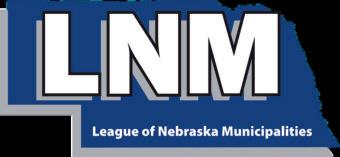
Chaired by Mayor Don Groesser of Ralston
Significant economic impact of “Creative Districts” is well documented across Nebraska!
BY L. LYNN REX, EXECUTIVE DIRECTOR, LNM
In 2020, Senators passed legislation enacting the Nebraska Creative Districts Program to promote economic development by utilizing the arts to support communities of any size, rural or urban, regardless of geographic location. Creative Districts are economic drivers that develop art venues like galleries and theatres which attract and retain businesses as well as an invaluable, talented workforce. Creative Districts also feature the district’s cultural and historical heritage, transforming it into a tourism destination.
Congratulations to Mike Markey, Executive Director of the Nebraska Arts Council, and his dedicated team for their tremendous advocacy and success in establishing 36 “Certified Creative Districts” throughout Nebraska with impressive economic outcomes, including the following municipalities: Alliance, Ashland, Auburn, Beatrice, Brownville, Chadon, Columbus, Cozad, David City, Falls City, Fremont, Grand Island, Hartington, Hastings, Holdrege, Kearney, Lincoln, McCook, Nebraska City, Norfolk, North Platte, Ogallala, Omaha, Oshkosh, Potter, Ralston, Red Cloud, Scottsbluff, Seward, Sidney, Tecumseh, Valentine, Valley, and York.
The 2025 Nebraska Arts Council Report on Creative Districts is an outstanding overview of the history, purpose, and economic impact of Creative Districts as outlined on page 5; this excerpt from the report underscores the remarkable percentage increases in sales tax, lodging tax, and the number of visitors to Creative Districts. Page 5 also highlights many of the “Pay-offs to Date” of the public art projects, visitor attractions, murals, festivals, and renovations of theatres and art centers. Please take time to read the entire report at www. artscouncil.nebraska.gov. The “Spotlight on Red Cloud” featured in the report explains how Red Cloud received public and private dollars, including a $250,000 “Creative District Development Grant” for a hotel coupled with a $562,000 Civic and Community Center Financing Fund (CCCFF) grant resulting in $4.5 million in public and private funds leveraged since Red Cloud received its certification as a Creative District.

If your municipality has not yet considered going through the process of establishing a Creative District, I strongly encourage you to do so to take advantage of funding opportunities and benefits to your city or village for decades to come. In addition to the 36 “Certified Creative Districts”, there are 24 communities already going through the process. Thanks to Rachel Morgan, Program Specialist with the Nebraska Arts Council, who has presented excellent sessions at various League conferences for the last few years. Rachel emphasizes the positive partnerships involving local businesses and the arts when fostering community engagement during and after the planning process to become a Creative District. These districts showcase economic growth with strategic planning that is actionable and measurable!
The certification process outlined on the Nebraska Arts Council website takes time to complete but is well worth the effort! The process begins with a Letter of Intent which “identifies the geographic area, promotable identify, and partnering leaders of the proposed Creative District.” The next step is the submission of a Workbook that describes a “cultural asset inventory, base-line statistics, engagement of the communities’ stakeholders, and strategic goals for growth.” After a Panel of Experts reviews the Workbook to assure necessary components for success, the staff of the Nebraska Arts Council tours the proposed district to meet with stakeholders, businesses, and leaders. Creative Districts have the responsibility to establish an identity and strategy for achieving self-sustainability.
The League is proud to be one of many partners advocating for the development of Creative Districts throughout our state! Other partners include Center for Rural Affairs, Humanities Nebraska, Nebraska Department of Economic Development, Nebraska Tourism Commission, Mid-America Arts Council, Nebraska Community Foundation, Peter Kiewit Foundation, as well as numerous Chambers of Commerce, local government agencies, civic groups, businesses, and arts organizations.
IMPACT economic
OF THE

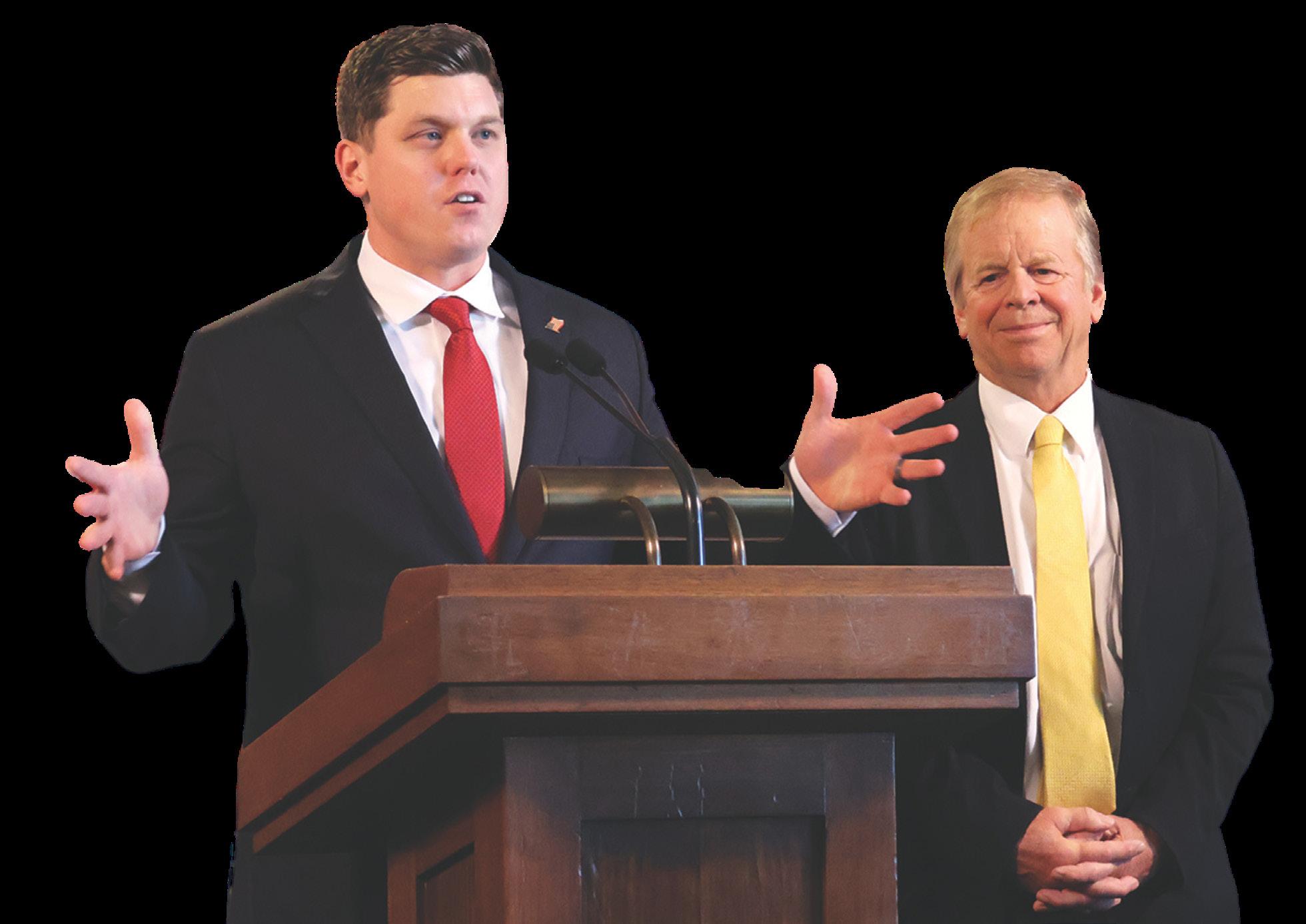
Congratulations to former Fremont Mayor Joey Spellerberg, his wife – Ashley, and their four children!
OnNov. 3, Gov. Pillen held a press conference and announced that Mayor Joey Spellerberg, League Vice President, would become the next State Treasurer. During the press conference, State Treasurer Tom Briese said he shared with the Governor about a month ago that he was considering resigning to spend more time with his family. Gov. Pillen stated he fully backs Mayor Spellerberg who confirmed that he will run for the office in 2026.
Although we will miss former Mayor Spellerberg on the League Executive Board, we wish him and his family only the very best and know he will do an outstanding job as our next State Treasurer.
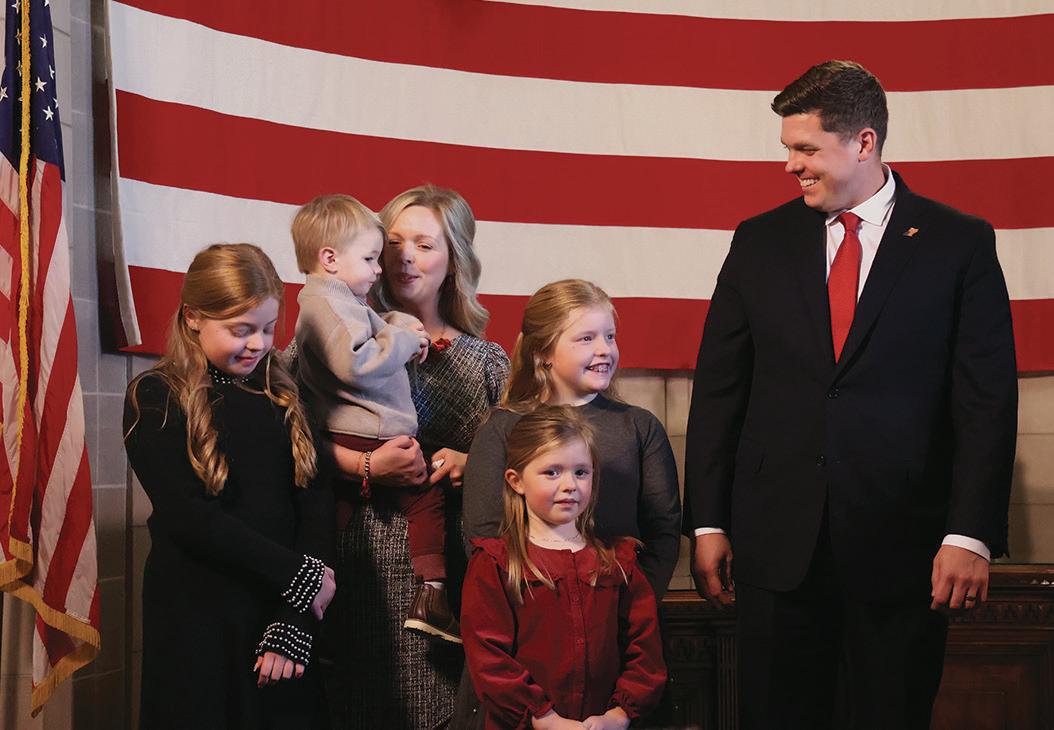
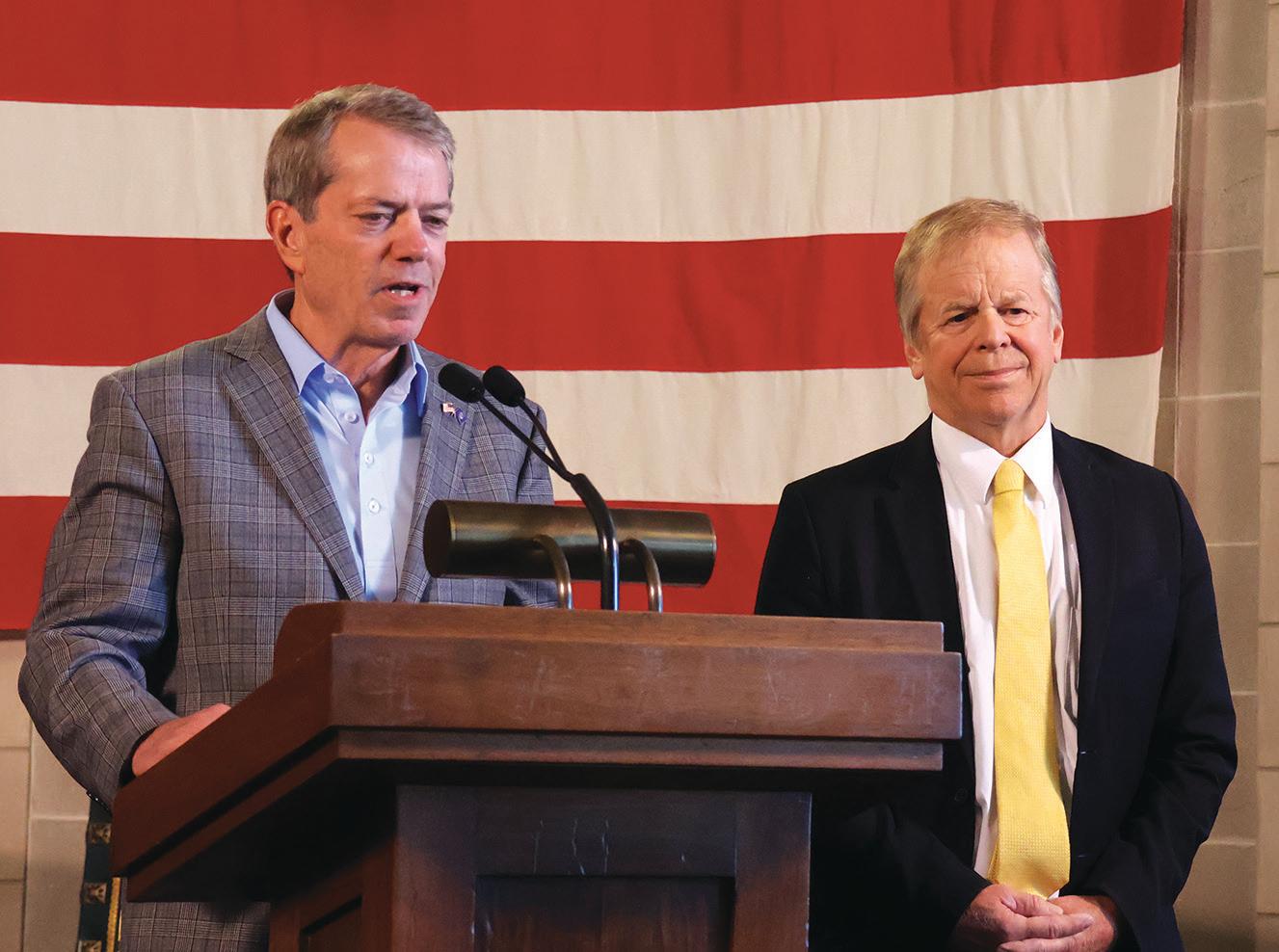
Top: Former Mayor Joey Spellerberg addresses the media at the Governor's press conference announcing his appointment as State Treasurer. Bottom left: Mayor Spellerberg stands smiling with his family. Bottom right: Gov. Jim Pillen thanks Treasurer Briese for his service to the State of Nebraska.
LEAGUE HOSTS LUNCH AND EMS BRIEFING


The League, NACO, Sen. Myron Dorn and Sen. Dave Wordekemper hosted a lunch and briefing for over 40 people in the Joe Hampton Conference Center on EMS Challenges facing Nebraska. State senators, county, and municipal officials gathered on Oct. 29 to learn more about potential funding opportunities from the federal government for a regional healthcare delivery system to improve health outcomes and enhance access to care. Michael Dwyer, Co-Chair of the EMS Task Force, and Gene Bradley, Director of EMS at the Community Medical Center in Falls City gave the briefing followed by questions from those in attendance.





Determining PRIORITIES
Legislative Committees meet to highlight focus for upcoming legislative session
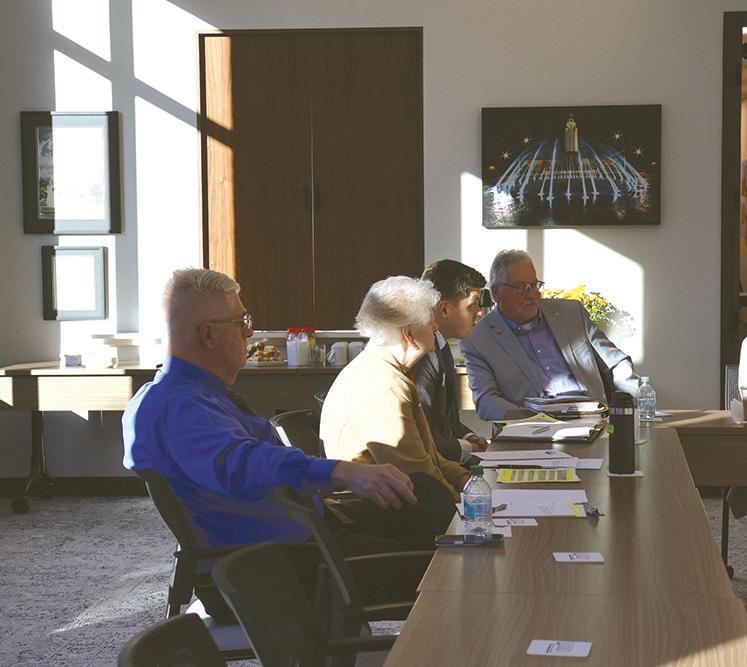

Members of the League's Larger and Smaller Cities Legislative Committees gathered in-person and virtually on Oct. 23 for the third meeting of the year. These groups are key in determining the legislative priorities for members ahead of the upcoming legislative session.
Items deemed a priority by the group include:
• Changing how municipalities provide notice under the Open Meetings Act;
• Increasing the amount of the minimum bid threshold; and
• Deferring frivolous lawsuits against municipalities. Thank you for all the feedback and we look forward to working with member officials in the upcoming session.
Smaller Cities Legislative Committee
Larger Cities Legislative Committee
GET A QUOTE AND JOIN TODAY!

The League Insurance Government Health Team (LIGHT) helps hundreds of its members throughout Nebraska obtain affordable health insurance coverage.
Plan and Network Choices
With seven plan options and three networks to choose from, you’re sure to find one that meets your group’s coverage and benefit needs.
Affordable Plan Options
Offering your employees much-needed protection against the high cost of medical care:
• Three PPO options
• Four HSA-eligible high deductible options
• Prescription drug coverage
Enrollment Options
Single: Covers the employee only
Employee and spouse: Covers the employee and their spouse
Employee and children: Covers the employee and their eligible dependent children, but does not provide coverage for the spouse
Family: Covers the employee and eligible dependents including a spouse
RECEIVE DEDUCTIBLE AND OUT-OF-POCKET CREDIT FROM YOUR CURRENT VALID GROUP PLAN WHEN YOU SWITCH!
Available Network Options
With several networks available, you have easy access to quality providers:
• NEtwork BLUE (Statewide)
• Premier Select BlueChoice (Regional)
• Blueprint Health (Regional)
• Out-of-state network availability
LET’S GET STARTED
Contact your current local Agent/Broker Or contact
Dennis Maggart
Executive Vice President P: 913-378-9841 or 816-718-0335
Dennis@McInnesGroup.com
Jane Limbach Account Man ager P: 913-378-9840
Jane@McInnesGroup.com
Center for Rural Affairs


Top 5 grant writing tips for rural leaders:
How to build proposals that persuade
BY DEBORAH SOLIE, CENTER FOR RURAL AFFAIRS
Writing a successful grant application is about more than filling out forms; it’s about telling your community’s story in a way that resonates with funders. Whether you’re new to grant writing or just looking to strengthen your next proposal, these tips can help you put your best foot forward.
1. Start with your story
When applying for a grant, don’t just list what you need; explain why it matters to your community. Frame your need in terms of community impact, urgency, and values. Share real stories, name the people or places impacted, and help the funder see the heart behind your work.
2. Apply for the right fit
Look for opportunities that align with your mission and values. Read the guidelines carefully, and tailor your application to reflect the funder’s priorities. Use their language, echo their values, and clearly show how your project supports their goals. If it doesn’t align, don’t apply—or if you’re unsure, reach out to the program contact.
3. Show local support
Funders want to know you’re not doing this alone. Even if your municipality is small, include letters of support, local partnerships, or volunteers involved. Highlight any collaboration between schools, churches, civic groups, or other nonprofits. It shows commitment and community buy-in.
4. Build a budget that tells the whole story
Keep your budget simple but clear. Funders want to know that you’ll spend the money wisely and realistically. Be honest about costs (even if small), include in-kind support if you have it (like donated space or volunteer time), and make sure the budget matches your mission.
5. Give yourself time and ask for help
Grant writing doesn’t have to be perfect, but it does take time. Try not to write in a rush. Ask a trusted colleague to review your draft, preferably someone outside your project who can point out unclear parts. If there’s technical language in the grant, ask for help translating it. You don’t have to do it alone. This post is based on content presented by Coneflower Consulting during “Finding the Funds, Framing the Story: A Grant Writing Workshop” hosted by the Center, June 2025. To learn more, visit coneflower.org
Grant writing goes beyond securing funding. When you take the time to craft a clear, compelling application, you build connections, tell your story, and invest in your community’s future.
New Little Free Libraries in Sutton

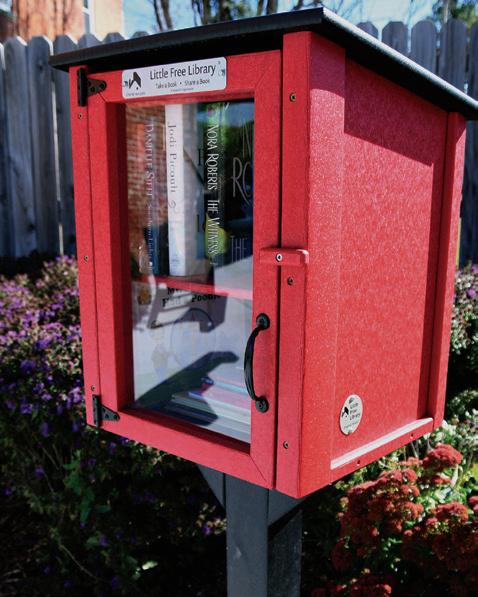
STORY PROVIDED BY CITY OF SUTTON
The City of Sutton was excited to support the installation of the new Little Free Libraries as part of our ongoing effort to promote literacy and community engagement. The project came together through a great partnership between city staff, and funding support from the Sutton Lions Club, Keno funds, Park funds, and Library funds.
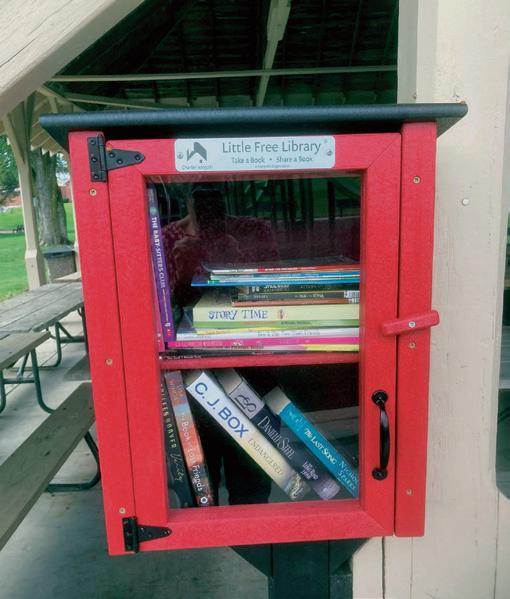
The Little Free Libraries are a simple, but meaningful way, to connect our community. They make books accessible to everyone and celebrate Sutton’s spirit of sharing and giving.
Warren Myers
Sutton City Administrator



AI in state and local government
Section 4
Three key phases of AI adoption
It might seem prudent to delay AI adoption until a fullfledged policy has been debated, amended, and approved by agency officials. The reality of AI suggests otherwise. “A lot of agencies are taking six to 12 months to write a policy that’s outdated by the time the policy is legislated and enacted,” Dunn says. “So we encourage experimentation simultaneously while drafting those policies.”
As noted earlier in this guide, agencies can spin up an AI solution in surprisingly short timeframes. This underscores the value of building policy as needed in the AI development process and finalizing it only when the project is ready to go live.
Here is a suggested three-phase approach:
Phase 1: Strategy, exploration, and ideation
Strategy
You’ll need a plan that maps out your path through all three phases. “There’s no need to reinvent the wheel,” McSpaden says. Ask colleagues or search online for basic strategy outlines. Don’t overlook the basics, such as funding, staffing, and skills.
You’ll also need an in-depth assessment of your IT environment to make sure you understand AI’s impact on your technology infrastructure. “You can’t have a good strategy without some sort of set of metrics to gauge your success,” McSpaden says.
Map out your basic policy requirements during this stage. Engage purchasing and procurement staff early to outline future purchasing needs and options to avoid conflicts or delays while exploring and ideating. When you’ve chosen your AI use case, it’s time to procure a solution. This does not have to be a long process. AWS, for instance, has a marketplace with AI products that can be acquired within the bounds of an agency’s procurement requirements. When you’ve procured the technology, start figuring out what it can do.
Exploration and ideation
Identify opportunities to automate agency processes, streamline constituent experiences, or create better outcomes in the community. When setting priorities, focus on a solution that provides measurable ROI without much risk and creates solid grounding for future experimentations. “Another key principle is scalability,” Deshpande says. “AI solutions should be designed to grow and adapt as the needs of an agency expand.”
Explore policy implications during this stage. Let’s say you want full transparency on how an AI engine reaches a conclusion. “It can’t be a black box,” Haisler says. A possible scenario: Your AI solution determines somebody is ineligible for a small-business loan program. “If that decision is challenged, you’re going to be on the hook to justify it,” Haisler adds. “You can’t say, ‘Well, the model told me so.’”
Issues like freedom-of-information requests and other government-specific obligations must be part of the policy outline you draft during this phase. Ask technology partners how they will satisfy your AI policy priorities.
Phase 2: Experimentation, testing, and policy refinement
Experimentation
Build a safe sandbox to explore the solution’s functions and demonstrate its potential. “Understanding the technology before regulating it is key,” Haisler says. Agencies can invite lawmakers and executives into the sandbox to demonstrate how the solution works. This lays the groundwork for the critical change management that will be required to encourage adoption after the solution goes live. Once leaders see what you can do, they’ll be better prepared to make sure the final policies fit your solution.
Testing
Bring in users from multiple agency departments and disciplines to help iron out wrinkles and build enthusiasm for adoption. “Technical details such as data usage, information security requirements, available technical guardrails, staff training needs, implementation costs, expected ROI, and anticipated risks and mitigations should all be captured during this phase,” Dunn says.
Make sure the people who will use the AI solution have opportunities to test it, uncover bugs, and recommend fixes. If it’s public facing, you may want to convene focus groups or other kinds of meetings to ensure exposure to non-users. You may also need a public awareness campaign that will encourage adoption.
Policy refinement
When you’re confident that your proof of concept works, update your policy with the governance fundamentals you’ve learned. Make sure to add technically specific information like technology partner fact sheets as appendices to your updated AI policy.
Phase 3: Implementation, monitoring, measurement, and expansion
Implementation
Your technology partners should be able to ensure you launch with few hitches. This is also the point where your policy should be ready for approval by decision-makers and elected officials. Dunn suggests having a fallback plan in case something unexpected happens that requires shutting the solution down.
Monitoring
Real-time data should reveal what’s working and where you need to improve. Talk to technology partners about establishing key performance indicators (KPIs).
Measurement
AI solutions produce an abundance of data that will let you track your KPIs, quantify benefits and costs, and assess vulnerabilities.
Expansion
When you’re confident, the solution satisfies your requirements, identify a new use case and apply everything you’ve learned. Your AI policy may need a few refinements specific to new needs. You can work those out in development just as you did with the first solution.
THIS IS FINAL INSTALLMENT IN A FOUR-PART SERIES REPRINTED WITH PERMISSION FROM e.REPUBLIC.

HOPE BEYOND
BORDERS:
Columbus Fire Department helps Zacapu firefighters
BY MATT LINDBERG, CITY OF COLUMBUS
WhenColumbus Firefighter Aaron Perez returned to the streets of his childhood home in Zacapu, Mexico, last week, he wasn’t carrying just memories - he had hope and a tangible gift that will save lives.
Alongside his wife, Centro Hispano Executive Director
Karina Perez, Columbus Mayor Jim Bulkley, Fire Chief Ryan Gray, City Councilwoman Cynthia Alarcón, Assistant Fire Chief Nate Jones, and CFD Capt. Derek Salak, Perez traveled to Zacapu for a four-day visit earlier this month.
The group brought more than 40 sets of bunker gear, boots, helmets, SCBA equipment, and firefighting monitors –donations from the Columbus Fire Department to their new sister city.
Although no longer standard in the United States, the donated Columbus Fire Department equipment is fully functional and gives Zacapu firefighters the essential tools they need to protect their community.
“It was completely unexpected,” Aaron Perez said. “Our
only goal was to meet the people who would be receiving this gear and show up. But what we experienced … it was overwhelming. The gratitude, the hospitality - literally the entire town welcomed us like family.”
Zacapu, a city in north-central Michoacán, Mexico, is known for its agricultural economy (wheat, beans, and corn), rich cultural heritage, and historical significance.
For Perez, seeing the city where he spent his early childhood brought waves of nostalgia and emotion.
“Being able to come back and see some of my cousins who still live there, and seeing the guys and girls volunteering their time over at the fire department have a little more equipment to do their job safely … it makes me appreciate this more,” Perez said.
The fire department in Zacapu responds to more than 1,000 calls a year in a town of roughly 75,000 residents, as of 2020. Chief Ryan Gray said the donated equipment, while no longer standard in the United States, was still in
Columbus Fire Chief Ryan Gray, back left, Mayor Jim Bulkley, and Firefighter Aaron Perez, second from the back right, pose for a photo with Zacapu city officials and firefighters during a September 2025 official donation ceremony in Zacapu, Mexico. Photo provided by the City of Columbus.
excellent condition - and for Zacapu, it’s transformative.
“These firefighters were doing their jobs with almost nothing,” Gray said. “To watch them put on this gear, to see the relief and the pride on their faces … it’s something I’ll never forget. In that moment, you realize how much of what we take for granted actually saves lives.”
Gray reflected on the moment of unity during a formal ceremony Sept. 12, as he and the Columbus delegation watched the Zacapu firefighters take ownership of the equipment.
“This is what unites us,” Gray told the crowd. “Whether in Columbus, Nebraska, or Zacapu … the heart of the firefighter is the same. We are bound by sacrifice, by service, and by love for our communities.”
The trip came at the request of Zacapu officials, who covered the expenses of the visit with Centro Hispano after they visited Columbus earlier this year. No Columbus taxpayers’ dollars were spent on this trip.
The visit also served as a reminder of the power of compassion in a politically charged climate where immigration enforcement and division often dominate headlines.
For Karina Perez, it was a somber example of how a love for fellow humans - regardless of race, age, sex, or creed - can bridge borders and inspire action.
“There’s a piece of this that resonates with many immigrants in our community,” Perez said. “Sometimes you feel like you’re neither from here nor there. But this shows you can love living in the United States and still love your home country - you can give back in both places.
The ceremonial handoff of the gear at the Zacapu fire station was a moment charged with emotion. Residents, officials, and firefighters filled the streets, cheering, clapping, and gifting small tokens of thanks to the delegation. Children ran up to hand little Capybara toys (tiny, handmade creatures) as a gesture of welcome.
“It was such an uplifting experience. It’s hard to describe,”
Mayor Jim Bulkley said, recalling two little boys coming up to him and Aaron Perez to gift them the toys. “There are truly not enough adjectives to tell how we were treated, how we were welcomed, how this equipment will be used and the appreciation we were given. As we walked the streets, we had people come up and thank us.”
Alarcón, who represents the First Ward on the City Council, echoed the mayor’s sentiment. “Never once did we expect to feel as welcomed as we did. They went above and beyond in every sense of the word. From our arrival and everything in between,”

she said. “We visited the fire station and they were sharing stories about using their existing resources and how this donation would make it better. It was really hard to hold back tears.”
For Aaron Perez, the journey started on social media a few years ago when he saw photos of firefighters in Mexico fighting fires without proper protection. It grew into months of work navigating legalities, logistics and international cooperation.
Perez spent the first eight years of his life in Zacapu, raised alongside his younger sister by a devoted mother while his father worked in the United States to provide for the family. He remembers frequent hospital visits and relying on his mother’s care and support.
“Growing up, I was a really sick kid, so I was in the hospital a lot. I needed a lot of treatments and stuff, so my mom had to take care of that while my dad was over here in the United States trying to provide for us,” Perez said.
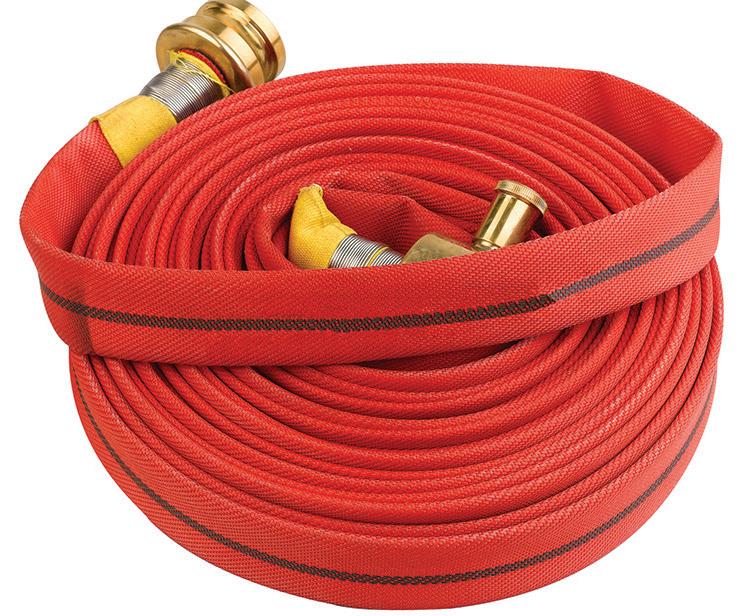
Continued on page 17 / See Firefighters
Columbus Firefighter Aaron Perez addresses those on hand for a September 2025 official donation ceremony in Zacapu, Mexico. Photo provided by the City of Columbus.
Significant donation jumpstarts community project

Big changes are coming to downtown Ralston to honor the late LaDonna Johnson
The City of Ralston recently held a groundbreaking to kick off the remodel of Independence Square. At the northwest corner of Main Street and Miller Avenue sits a gazebo built in the mid-1990s and a brick plaza area. Through years of weather-wear and usage, this community centerpiece has seen better days, but the City of Ralston will soon have a new gazebo, plaza area, and water fountain to honor the late LaDonna Johnson, who was a longtime resident of the municipality.
In 2019, La Donna Johnson and her family gave a $7.5 million gift to the City of Ralston to help provide critical funding for an economic development effort known as the Hinge Project. Her initial donation has helped spur over $100 million in proposed investments in the Hinge Area to date. For those not from the Ralston area, the Hinge Project is an economic development vision to
Continued on page 20 / See Ralston
Firefighters
Continued from page 15
Despite the challenges, he recalled his childhood as beautiful, filled with family, community, and the lessons of his heritage. Returning years later as a firefighter bringing life-saving equipment to the local fire department was a full-circle moment.
City officials had high praise for Perez. And though this was truly about two communities coming together, the Columbus firefighter was at the epicenter of it.
“Aaron had the vision,” Mayor Bulkley said. “That led to Zacapu’s mayor and leaders coming up here. From that visit, they coordinated the shipping, all of the details, and our trip down there.”
Alarcón said she was especially moved by seeing the firefighter so supported.
“It was just great to see how touching it was for a city employee to have that honor and be recognized in his hometown, in his home country,” she said. “Although he didn’t do it for the recognition, through all the smiles and tears, you could see the hard work paid off.”
Second Ward City Councilwoman Kat Lopez, who also serves as Centro Hispano’s communications director, said she admired the collaboration between Aaron, the City, and Centro that made this project happen.
“Aaron took a really big step in his dream by converting it to something that he made possible for others to look at. The partnership has been really beautiful and how it developed,” Lopez said. “I think this is just one of the many things that the city and Centro can work on. Seeing both sides of the story - the city and the community - come together is something to be proud of.”
While some of the gear donated from Columbus was no longer standard in the United States, it far exceeded what many firefighters in Zacapu had access to, providing critical protection that will save lives.
“At the end of the day, we’re all cut from the same cloth, we all have the same basic needs. If we don’t take care
ABOUT ZAPACU
” “
Aaron
had the vision [and] that led to Zacapu’s mayor and leaders coming up here. From that visit, they coordinated the shipping, all of the details, and our trip down there.
Jim Bulkley, Mayor of Columbus
of one another, who will?” Gray said. “This is a great example of that.”
Along with the City’s contribution, Charlee Shraer at MMT Ambulance donated medical supplies to get to Mexico, while Miguel Sanchez of Cannonball Express helped deliver and provided heavy-duty boxes to contain the equipment.
The trip might be done, but the partnership has only just begun. Mayor Bulkley said he hopes the Sister City arrangement will lead to more collaboration between Columbus and Zacapu, hopefully inspiring fellow Nebraska communities to create partnerships like it with communities across the world.
The Columbus firefighter who started it all is all for it, noting his appreciation to Mayor Bulkley, Chief Gray, City Administrator Tara Vasicek, the Columbus City Council, his colleagues, and Centro Hispano for supporting the effort.
“It’s just honestly what’s making me feel like, I appreciate this more,” Perez said. “I want to make something happen where we can continue this and move it to a bigger scale.”
Zacapu is a city in north-central state of Michoacán. The municipality lies west of the capital city of Morelia
• Population: 76,829 (according to the 2020 census).
• Elevation: Located in the Nahuatzén Mountains, 6,500 feet above sea level.
• Economy: Primarily agriculture - wheat, beans , corn and raising livestock.
• Tourism: Several Tarascan Indian sites are nearby.
• Accessibility: Zacapu is accessible by highway and railroad.
FROM ACCIDENT TO IMPROVEMENT:
A supervisor’s role
Workplace accidents, incidents, and near misses are more than isolated events, they are opportunities to strengthen safety culture, improve operational practices, and reduce long-term risk. For municipalities facing rising insurance costs and increased scrutiny, supervisors play a pivotal role in ensuring that every incident is investigated thoroughly, documented accurately, and used as a learning tool for future prevention.

BY JAMES KELLEY, LOSS CONTROL SPECIALIST, LARM

Investigate promptly and on-site
Example:

Timeliness is critical. Investigations should begin as soon as possible, ideally at the scene of the incident. This allows supervisors to observe environmental conditions, equipment status, and other contextual factors that may be lost over time. Gathering first-hand accounts while the event is fresh in employees’ minds improves accuracy and helps identify contributing factors that might otherwise be overlooked.
After a parks department employee was injured while using a hedge trimmer, the supervisor arrived on-site within 30 minutes. They noticed the trimmer’s guard was missing, a detail that might have been missed if the investigation had been delayed. This led to a review of equipment inspection protocols and a refresher training on tool safety.
Encourage open communication
Tip:

Supervisors should create a space where employees can speak freely and without interruption. Listening actively then repeating the details back to the employee helps confirm understanding and ensures that the account is accurately captured. This technique also builds trust and reinforces the collaborative nature of the investigation.
Use phrases like, “Let me repeat what I heard to make sure I understand,” or “Can you walk me through what happened again, step by step?”
Conducttrainingpost-incident
Case Study:

Once the investigation is complete, supervisors should organize training sessions to review lessons learned and update procedures as needed. These sessions should be inclusive, engaging, and focused on equipping staff with the knowledge and tools to prevent similar incidents.
A water utility department held a post-incident workshop after a valve failure caused flooding in a service area. The training included hands-on valve inspections and a review of emergency shut-off procedures. The result: improved response times and fewer equipment failures.
Conclusion: Lead with accountability and learning



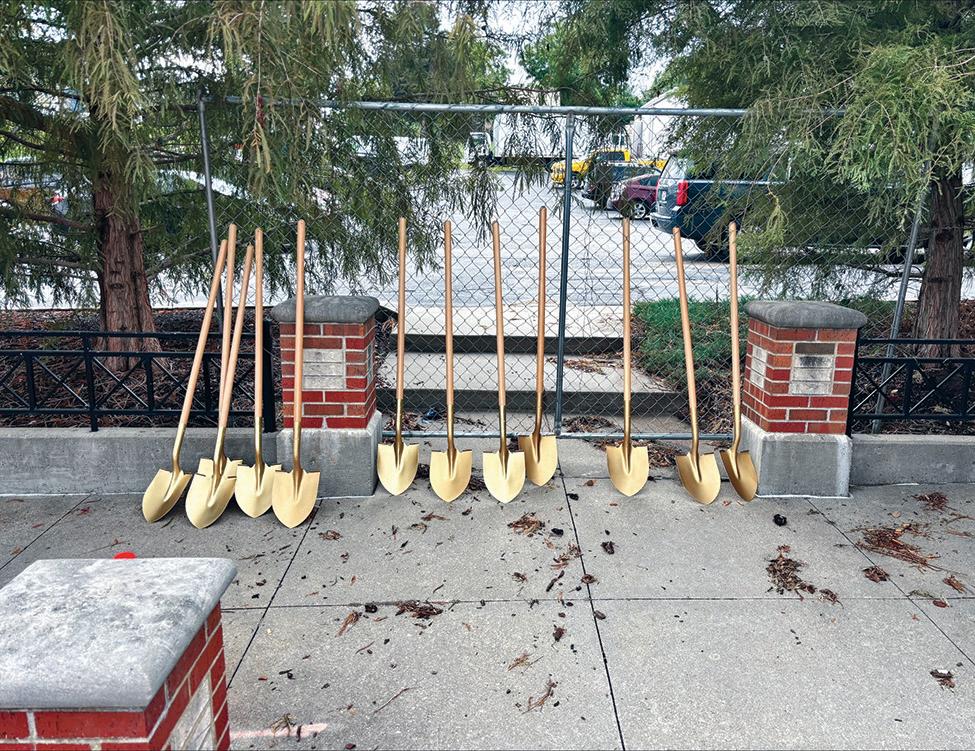
Ralston
Continued from page 16

develop the area around 72nd and Main Streets so it serves as a connection between the arena and the city’s downtown. The idea came out of the city’s 10-year comprehensive plan completed in 2014, and includes mixed-use developments, entertainment, and dining areas. The plan is designed to attract new residents and businesses and provide more amenities for Ralston visitors and residents.
The $7.5 million gift from a former Ralston resident provided critical funding for the economic development known as the Hinge Project and put Ralston on the right path to the future, according to Ralston Mayor Don Groesser.
“LaDonna Johnson’s incredible generosity will unite the community. Her donation allows the city to be a strong partner with the private sector and bring the Hinge Project to
life. Existing businesses will benefit from the vitalization of our commercial areas. Taxpayers will benefit because the initial investment will come from the Johnson donation rather than city dollars. LaDonna’s amazing gift has ensured the Hinge will truly be a project for Ralston, by Ralston,” Groesser said.
Johnson was a strong proponent of the Hinge Project and her bequest states that the gift must be used only in furtherance of the effort.
The only other request LaDonna Johnson made when giving her generous donation to Ralston was that a community, centerpiece, outdoor fountain be built for the residents and guests to enjoy. The City of Ralston now stands ready to honor her request and is moving forward with plans.
The fountain will be 20 feet across at its base and rise
A large donation made in 2020 has allowed the City of Ralston to move forward with a large community improvement project. The multi-faceted project is intended to better connect the area surrounding the arena to downtown Ralston and draw in additional amenities and visitors.
with boulders and vases. It will be an impressive fountain with water and lighting that will run year-round with minimal maintenance.
“Once completed, it will be an absolutely gorgeous and wonderful addition to the downtown area.
Ralston residents will be proud of it and visitors will stand in awe as they admire its beauty,” Mayor Groesser said.
The entire NW point will be under construction for at least six months.
The improvements will include the fountain, new gazebo, plaque honoring LaDonna Johnson, paving, landscaping, lighting, new sound system and other amenities including new parking to the west of the gazebo.
“Ralston is a great community with a high quality of life because of the foresight of those who came before us. Each generation has planned for the next,” Mayor Groesser said.
“Thanks to the Johnson family’s gift, that tradition will continue. Today is a great day for Ralston.”


Engineering a world where everyone thrives.


Tara Stingley
Preventing and addressing sexual harassment in the workplace
BY TARA A. STINGLEY, CLINE WILLIAMS WRIGHT JOHNSON & OLDFATHER, L.L.P.
Approximately eight years ago, in October 2017, the #MeToo movement gained widespread attention, as a global social movement against sexual abuse, sexual violence, and sexual harassment. Despite the significant global attention to this issue, sexual harassment in the workplace continues to be a problem. The number of harassment charges filed with the Equal Employment Opportunity Commission (“EEOC”) and the Nebraska Equal Opportunity Commission has steadily increased over the past several years.
With sexual harassment in the spotlight, it is more important than ever for employers to review their organization’s policies and procedures to prevent sexual harassment and to adequately respond to complaints about harassment in the workplace. This article provides practical tips for organizations to follow to prevent and address harassment in the workplace.
A. What is Sexual Harassment?
Sexual harassment is a form of sex discrimination that violates Title VII of the Civil Rights Act of 1964, as well as applicable state and local laws. The EEOC defines sexual harassment as unwelcome sexual advances, requests for sexual favors, and other verbal or physical conduct of a sexual nature when submission to or rejection of the conduct affects an individual’s employment; unreasonably interferes with an individual’s work performance; or creates an intimidating, hostile, or offensive work environment.
There are two categories of sexual harassment: quid pro quo and hostile work environment.
1. Quid Pro Quo
Quid pro quo is a Latin phrase meaning “this for that.”
Quid pro quo harassment applies to situations in which a supervisor makes demands in return for a job benefit or to avoid a job detriment. For example:
• A supervisor telling an employee that going on a date with the supervisor will lead to career advancement; or
• A supervisor telling an employee that not going on a date with the supervisor will result in the employee never being promoted.
To establish a case of quid pro quo harassment, the employee generally must prove the following:
• The employee is a member of a protected group;
• The employee was subjected to unwelcome sexual harassment in the form of sexual advances or requests for sexual favors;
• The harassment was based on sex; and
• The employee’s submission to the unwelcome advances was an express or implied condition for receiving job benefits or the refusal to submit resulted in a tangible job detriment.
Employers may be strictly liable for harassment that results in a tangible employment action. Tangible employment action can include termination of employment, failure to hire, failure to promote, reassignment with significant changes in quality or quantity of work, a change in benefits, and unfavorable compensation decisions.
2. Hostile Work Environment
Quid pro quo harassment generally only applies to sexual harassment. In contrast, hostile work environment harassment applies to all forms of unlawful harassment. Harassment based on any protected class can constitute hostile work environment harassment.
To establish a hostile work environment sexual harassment claim, the employee generally must demonstrate the following:
• The employee is a member of a protected group;
• The employee was subjected to unwelcome sexual harassment;
• The harassment was based on sex; and
• The harassment affected a term, condition, or privilege of employment. Employers may be able to avoid potential liability by asserting the FaragherEllerth defense. To assert this defense, an employer must be able to demonstrate:
• No tangible adverse employment action was taken against the employee;
• The employer exercised reasonable care to prevent and promptly correct the harassing behavior; and
• The employee unreasonably failed to take advantage of any preventative or corrective opportunities provided by the employer or to otherwise avoid the harm.
The defense protects employers who exercise reasonable care to prevent workplace harassment. The availability of the Faragher-Ellerth defense demonstrates the importance of having an effective anti-harassment policy and dedicated human resources personnel who can properly implement policies and respond to harassment complaints.
B. Preventing and Addressing Harassment
An organization that is effectively prepared can help prevent and properly respond to harassment in the workplace. The following five tips may be helpful for employers to consider in this context and generally apply to both sexual harassment and any other unlawful harassment in the workplace.
1. Implement and Maintain an Effective Anti-Harassment Policy
Employers should have an anti-harassment policy in place. The policy should be consistent with applicable federal, state, and local law. An anti-harassment policy should prohibit all forms of unlawful harassment.
The policy can be part of the employee handbook or manual, or it can be a stand-alone policy. However, the policy should be readily available to both current employees and new hires. If you have not reviewed or updated your anti-harassment policy in the past few years, now is a good time to do so.
The policy should make clear that there is no tolerance for any harassment in the workplace. In addition, the policy should also prohibit retaliation for complaining about harassment.
The policy should also include clear instructions for reporting harassment. The reporting policy should be in plain language and easy to understand. Generally, reporting involves a two-step process: first, ask the harasser to stop, unless this would make the individual uncomfortable; and second, report the harassment to superiors or human resources.
2. Promote Compliance
Instill within your organization a culture of compliance regarding the antiharassment policy. Implement a zero tolerance harassment policy. Even though certain comments or actions may not be actionable under the law, a zero tolerance policy enforces the organization’s commitment to a safe and harassment-free workplace.
If a supervisor or human resource professional observes harassment, even if no one complains, the harassment should be addressed immediately. Supervisors
Continued on page 26 / See Legal
Building a Better Future in NEBRASKA With
a Strong Public Finance Partner
Our bankers specialize in:
• Bond Anticipation Notes
• Paving Bonds
• Water and Sewage Bonds
• General Obligation Bonds
• Utility System Revenue Bonds
• Lease-Purchase Financing
D.A. Davidson & Co. is committed to strengthening the infrastructure and enriching the lives of people in our communities throughout Nebraska and across the nation. Call: (402) 392-7986 | Paul Greiger (402) 392-7989 | Cody Wickham (402) 392-7988 | Andy Forney (402) 392-7933 | Jerry Spethman


WHAT WILL BE NEW IN 2026?
BY SHARI SORENSON, RECREATION GRANT ADMINISTRATOR, NG&P

Land and Water Conservation Fund in Nebraska will be introducing several improvements and a new opportunity in 2026.
We are combining a mapping system and a grant management system to provide a more intuitive journey for the application, managing an award, and tracking the property that must stay in outdoor recreation. We began touring the state to visit every park site which has received LWCF funding in the summer of 2024 and will continue into the summer of 2026. That means we will be in every county except four since the program has granted over 1,100 awards in Nebraska!
In our LWCF site visits, it was obvious how much pride communities take in their parks and a great reflection of the public’s desire to use outdoor recreation areas. The most common finding in regards to compliance, was the lack of an LWCF acknowledgement sign, which is required. This is a minor issue that we are responding to by increasing our sign inventory to assist project sponsors! Communities, where a site visit has occurred, will receive a compliance letter and report, over the next few months, indicating if any action is needed. This site check is a requirement of the program. So, if you see a Game and Parks vehicle and a staff person wandering through your park and snapping photos, it is probably us! Feel free to chat or ask us questions!

The site visits brought our attention to the need for smallscale refurbishment projects, so we are responding! In 2026, we are switching things up from the way it’s always been. In addition to the standard full LWCF project, we will be offering a lower floor and ceiling grant for properties with an LWCF encumbrance. Look for more details in 2026.
We are also evaluating the application window for LWCF and the Recreation Trails Program (RTP). The two program application windows have occurred at the same time and during the busiest time for park personnel, so we are revising! We hope to separate the application windows so RTP funding awards can be used as a match for LWCF projects. Perhaps RTP applications earlier in the year and LWCF later in the calendar year. We would love to have your input – feel free to take this survey. Link: https:// arcg.is/XGKiD1
If you wish to be informed with each of these changes, please sign-up for our monthly LWCF Enews by emailing Shari Sorenson, Recreation Grants Administrator, at shari. sorenson@nebraska.gov. We wish everyone good health during the holidays and some time off with nature, family, and friends. Enjoy the outdoors wherever you may be! We look forward to connecting with you in 2026 and showcasing our many improvements to the program.



Wisner Central River Park Trail Generations Park, Blair
Nebraska’s Cowboy Trail, Valentine
Municipal clerks and treasurers
attend statewide training in Wakefield
Thirty-two clerks and treasurers from across the state gathered in Wakefield on Oct. 18, for a day of professional training sponsored by the Midwest Assistance Program (MAP).
MAP is a nonprofit organization dedicated to helping rural communities and tribal nations across nine states in the Midwest. The program is dedicated to supporting communities in improving the environment, quality of life, and achieving self-sustainability, through training and technical assistance in all areas of management, finance, and operations. This is the second year in a row that MAP has hosted the training in Wakefield, continuing its effort to support local officials through hands-on education and collaboration.
The no-cost training included presentations from Samantha Wheeler and Shane Bush, both of MAP, John Hobbs from the League Association of Risk Management (LARM), and Lynn Rex with the League. Topics included grants, loans, recordkeeping, safety committees, asset management, and the Nebraska Open Meetings Act.
The event was supported by an Environmental Protection Agency (EPA) grant, enabling participants to earn up to five hours of continuing education credit toward fulfilling LB 781 requirements. For more information on this, or any other type of training through MAP, please contact Samantha Wheeler at swheeler@ map-inc.org.
Source
– Pam Vander Veen, City of Wakefield


Continued from page 23
and human resource professionals should be proactive in addressing and responding to harassment in the workplace and promoting the organization’s anti-harassment policy. Additionally, encourage employees to use the internal complaint procedure outlined in the anti-harassment policy. When an employee makes a complaint, take the complaint seriously. Employees will feel more comfortable informing the organization about harassment if they know their complaints will be taken seriously.
3. Train Employees
All supervisory personnel should be trained on the organization’s anti-harassment policy. In addition, supervisors should be trained on how to promptly and adequately respond to harassment complaints or questions. Since supervisors can be a point of contact for complaints, supervisors must understand how to react when a situation arises and how to elevate harassment complaints for further review.
All new employees should also receive training on the organization’s anti-harassment policy. Moreover, all employees should receive refresher training on the organization’s anti-harassment policy on a regular basis.
Consider having someone from outside the organization conduct the anti-harassment training. Outside resources, such as legal counsel, can present real-life situations and examples to demonstrate what harassment looks like in the workplace. Often, employees may be more comfortable discussing harassment with someone not associated with the organization.
Document all employee training by obtaining sign-in sheets or written acknowledgement forms for attendees.
4. Promptly Investigate Allegations
Respond to any allegations of harassment promptly and in a manner designed to end harassment. A prompt investigation can identify the problem and an appropriate solution and potentially reduce the risk of litigation.

Depending on the nature of the complaint, it may be necessary for a human resource professional or third party neutral investigator to interview the complaining employee, witnesses, and the accused employee in a timely manner. Often, witnesses’ memories may fade with time. A prompt investigation is likely to produce more accurate facts.
In addition, the investigation process should be properly documented, with relevant documents, communications, and other evidence (such as emails, text messages, instant messaging, and security video footage) memorialized and preserved as part of the investigation.
5. Enforce Policies Consistently
An employer’s failure to consistently enforce its antiharassment policy can result in further discrimination claims in addition to harassment claims. Employees should be trained on how to adhere to the anti-harassment policy in a consistent manner. Of course, not all situations will be identical in nature. However, employers must be able to consider the nature of the conduct at issue, the parties involved, and the organization’s policies in evaluating what action should be taken to address harassment.
C. Conclusion
Unfortunately, harassment continues to pose a problem within American workplaces. The guidance outlined above can help employers prevent and properly respond to harassment in the workplace. Not only will implementing these points promote a safe and harassment-free workplace, but they can also reduce the risk of costly litigation.
Editor’s Note: This article is not intended to provide legal advice to its readers. Rather, this article is intended to alert readers to new and developing issues. Readers are urged to consult their own legal counsel if they wish to obtain a specific legal opinion regarding their particular circumstances.
The author of this article, Tara A. Stingley, can be contacted at Cline Williams Wright Johnson & Oldfather, L.L.P., 12910 Pierce Street, Suite 200, Omaha, NE 68144, (402) 397-1700, tstingley@clinewilliams.com, or www.clinewilliams.com.

NDOT highlights progress made possible by Nebraska Legislature’s recent investments
Recentlythe Nebraska Department of Transportation (NDOT) provided an update on the statewide impacts made possible by one-time appropriations approved in 2024 by the Nebraska Legislature and Gov. Jim Pillen.
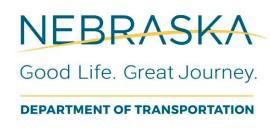
During the 2024 legislative session, state policymakers authorized a $70 million allocation to NDOT to offset inflationary pressures and accelerate the completion of much needed transportation projects. Funding was derived from the federal American Rescue Plan Act (ARPA) and the state’s Jobs and Economic Development Initiative Act (JEDI) through LB 1412 (2024).
“Our agency recognizes the significant commitment of resources dedicated to preserving and enhancing Nebraska’s transportation network and is thankful to Governor Pillen and the lawmakers who supported the investment,” said NDOT Director Vicki Kramer. “The ARPA/JEDI investment will have a direct impact on the safety of the highway system statewide and through the dedication and hard work of our public servants, meaningful improvements have been made in a relatively short amount of time.”
The following are highlights of the progress made possible by the 2024 allocation:
Progress on the US-275 Expressway corridor
The allocation, coupled with the use of bonding authority, condensed the schedule to complete the four-lane expansion of US Highway 275 (US-275). This corridor is vital to the economy and quality of life of northeast Nebraska since it connects the region’s agricultural and manufacturing hubs to major metropolitan markets, as well as the national transportation network.
Maximizing Transportation Grant Opportunities for Nebraska Communities
Preservation of 250-plus miles of state highways
The allocation was used to support 14 pavement preservation projects located in 23 Nebraska counties, covering nearly 260 miles of state highways. These projects focused on extending the surface life of existing rural roadways, which improves safety, and reduces annual maintenance costs. Only one of the 14 projects remains under construction – and the remaining project is expected to be completed yet this fall. This marks a rapid design, contracting and construction of these projects.
The allocation supported Nebraska Infrastructure Hub (I-HUB) activities. Launched in 2024, the I-HUB was created to help Nebraska’s local agencies access the unprecedented federal funding made available through the federal Infrastructure Investment and Jobs Act (IIJA). I-HUB provides grant pairing tools, technical assistance, and project development support — helping Nebraska communities and counties compete for and secure additional discretionary grants.
At last check, I-HUB had engaged with representatives from all 93 Nebraska counties, while NDOT staff traveled over 6,800 miles to meet with 316 stakeholders in 15 counties and provided more than 232 hours of direct assistance. In 2024, Nebraska received 37 awards in 18 counties totaling more than $56 million in discretionary transportation grants, and $98 million in Congressionally directed spending. So far in 2025, six awards have been announced across four counties totaling nearly $74 million in discretionary transportation grants.
“Investments in Nebraska’s transportation network directly support the vitality of the state,” Kramer added. “NDOT, under the leadership of Governor Pillen, is looking forward to continuing its collaboration with the Legislature, Highway Commission, and Infrastructure Review Task Force as our agency examines proven strategies to enhance economic growth through investment in transportation. We are committed to ensuring that funds invested in transportation provide a safer, more competitive, and more connected Nebraska.”
Source – Nebraska Department of Transportation

SOUTH SIOUX CITY:
Local and state collaboration creates hundreds of jobs, generates more than $300M in economic investments
With the expansion of local businesses, investment in infrastructure, and development of housing, South Sioux City (pop.13,744) has earned continued recognition for economic growth from the State of Nebraska. This week, the Department of Economic Development (DED) announced the City’s recertification as an Economic Development Certified Community (EDCC). Lt. Gov. Joe Kelly and DED Director Maureen Larsen presented the community’s EDCC recertification on Sept. 22. DED Director of Field Services Sheryl Hiatt joined state officials to honor the community for continued leadership in the program.
“South Sioux City’s dedication to development is well-deserving of recognition,” said Lt. Gov. Joe Kelly. “The community is supporting business expansions, constructing hundreds of new housing units, and has qualified as an inland port to incentivize additional industrial growth. Congratulations to South Sioux City on achieving recertification as an Economic Development Certified Community!”
South Sioux City was one of Nebraska’s first communities to earn EDCC
South Sioux City is, above all, a welcoming community where families can put down roots and thrive.
Lt. Gov. Joe Kelly, South Sioux City City Administrator Lance Hedquist, South Sioux City Economic Development Director Oscar Gomez, City Councilman Randy Meyer, and Nebraska Department of Economic Development Director Maureen Larsen. Photo provided by NDED.
ROD KOCH, MAYOR OF SOUTH SIOUX CITY
”
status in 2006, following the program’s creation in 2005. South Sioux City is one of 40 communities in the EDCC program, which is sponsored by the Nebraska Diplomats and administered by DED. State officials established the EDCC program to recognize communities for their preparedness to attract new industries and support existing businesses. Each certified community must engage local businesses in building programs that support a welcoming environment for development. EDCCs must document available sites and buildings, market their communities online, and create local financing and incentive programs. DED recertified South Sioux City in the EDCC program in 2011, 2016, 2020, and 2025.
Over the past five years, leaders in South Sioux City have undertaken infrastructure improvements and assisted business expansion projects. These efforts have resulted in 240 new jobs and $349,320,524 in investments in the community since 2020. The city completed a $62 million Wastewater Treatment Facility in 2023. The community has also collaborated with the State of Nebraska to support significant growth of area businesses. DED assisted projects at Scratch and Peck Feeds and Gerkin Windows and Doors through Nebraska’s Site and Building Development Fund (SBDF). DED also supported an expansion project at Sioux City Tarp, Inc., through the Community Development Block Grant (CDBG) Economic Development program.
In early 2025, DED announced South Sioux City as Nebraska’s fifth community to be certified as an Inland Port Authority. The community’s inland port includes a large industrial site located near Interstate 29 and the Missouri River.
“South Sioux City’s growth is a direct reflection of the hard work and pride of our residents and local businesses,” said City Administrator Lance Hedquist.
“From new housing and parks to the Inland Port Authority designation that opens over 1,600 acres for future development, we’re building a strong foundation for families and employers alike. Together, we’re ensuring South Sioux City remains a vibrant, welcoming place to live, work, and invest for future generations.”
Local leaders continue to prioritize housing development in South Sioux City, and they expect the completion of 231 single-family units and 480 multi-



WATER TOWER LIGHTS
SIOUXLAND FREEDOM PARK WALL
WASTEWATER TREATMENT FACILITY
family units by the end of 2028. The city received funding from DED for housing site preparation at the Missouri View Subdivision in 2023 for the creation of 72 singlefamily units. In 2021, Nebraska’s Affordable Housing Trust Fund assisted in the 42 single-family unit Ogden Housing Development.
Additional ongoing projects in the community include new bike trails and park improvements. In 2023, Siouxland Freedom Park opened a new interpretive center to honor local veterans. Earlier this year, the community celebrated the opening of an Early Learning and Child Development Center at the YMCA. The $5 million project expanded the YMCA’s current location and added 100 openings for families seeking local childcare. DED invested in both projects with funding from shovel-ready grant programs.
South Sioux City Mayor Rod Koch stressed the
importance of taking on local projects to enhance the area’s quality of life.
“South Sioux City is, above all, a welcoming community where families can put down roots and thrive,” Mayor Koch said. “With a strong school district, new housing, beautiful parks, and growing opportunities for good jobs, we’re creating a safe and vibrant place where children can grow, neighbors look out for one another, and every generation can proudly call home.”
Enhanced educational opportunities for South Sioux City students have been implemented to help grow the area’s workforce. South Sioux City High School recently created a career academy. Northeast Community College completed a new Commercial Driver’s License (CDL) training facility in 2024. CDL holders are authorized to drive vehicles that are often utilized in businesses, such as tractor-trailers and delivery trucks.
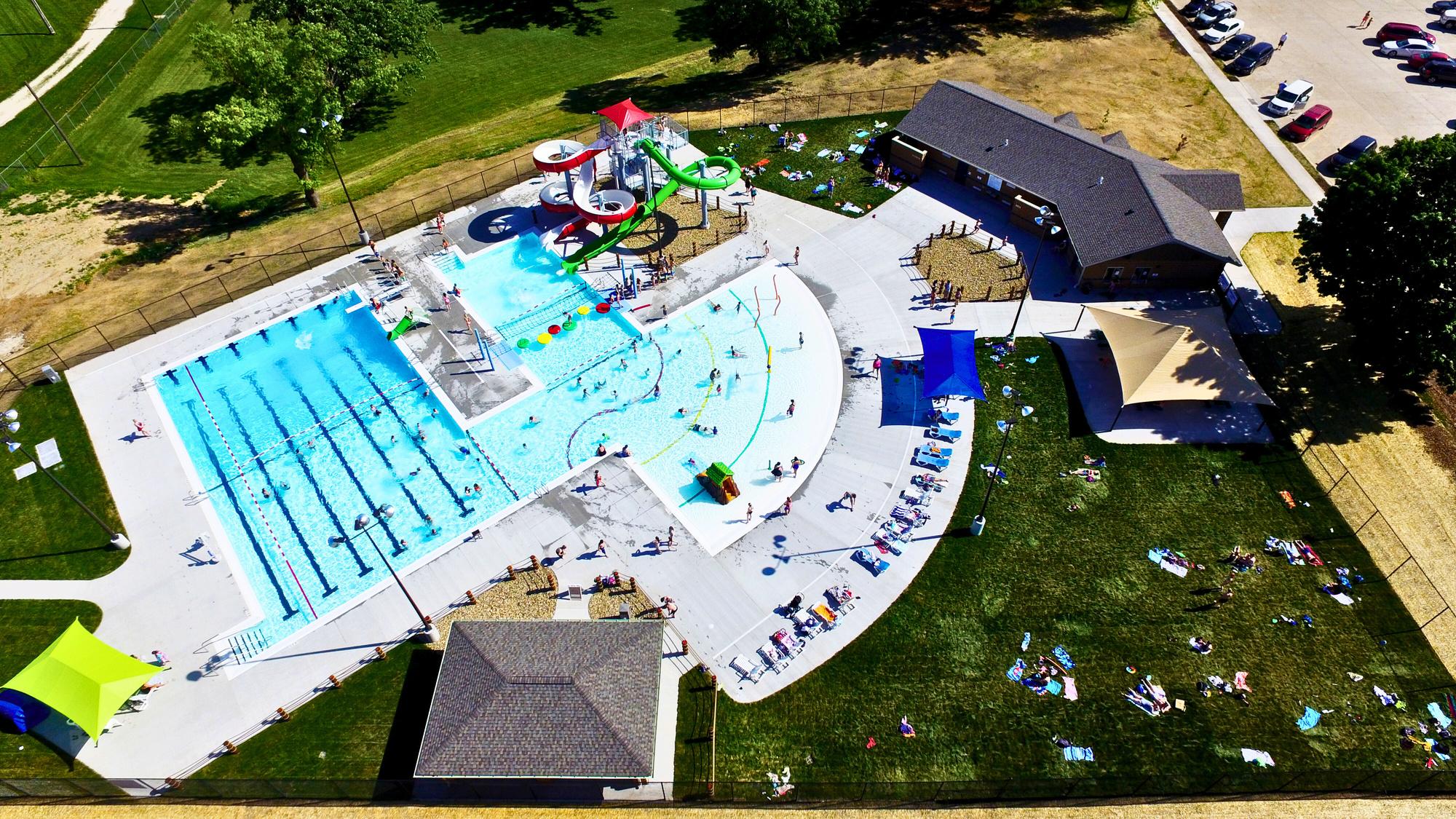



Fall colors in Scribner




www.mcodeservices.com


Photo shared on the City of Scribner Facebook page.

